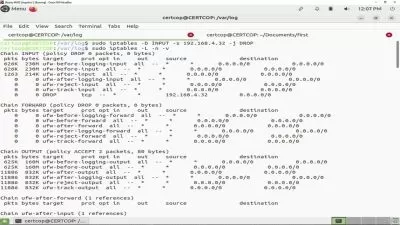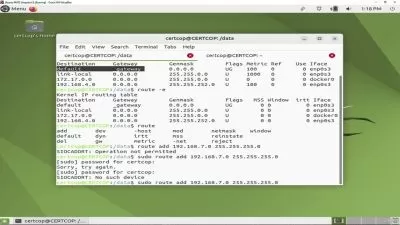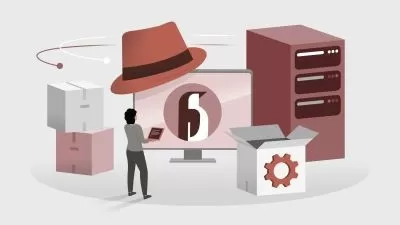Linux Foundation Certified Systems Administrator - LFCS
Mumshad Mannambeth,KodeKloud Training
12:36:21
Description
Prepare for the Linux Foundation Certified System Administrator (LFCS) Exam
What You'll Learn?
- Get Linux Foundation Certified System Administrator (LFCS) certified
- Learn Essential commands and Operation of running systems
- Learn User and group management
- Understand concepts with animated illustrations in our lectures
- Learn Networking, Service configuration and Storage management
Who is this for?
What You Need to Know?
More details
DescriptionLinux is the most widely used and best-known open-source operating system and can be found in embedded systems, smartphones, web servers, and supercomputers. Over the decades, Linux has become a key component in the infrastructure of nearly every major enterprise. Linux is also part of the backbone of the DevOps world, where it serves as both a development and distribution platform for many key tools.
The Linux Foundation’s Certified System Administrator exam is a hands-on, practical exam. The exam is designed to test applicants on the core domains of knowledge and critical skills that successful Linux system administrators need. Our LFCS course is designed to help you build those skills and prepare for the Linux Foundation Certified System Administrator exam.
In addition to LFCS training, lectures, and demonstrations, you will also have access to hands-on labs for every topic. At each step, you will be challenged to apply the skills you have learned with practical tasks. The labs can be accessed using your browser and will provide instant feedback as you move through each set of objectives.
What you will learn in our LFCS Course:
In this course, you will learn about
Essential commands
Operation of running systems
User and group management
Networking
Service configuration
Storage management
Practice is key!
Deep dive into our course content with challenging lab exercises and hands-on labs.
Course Update Notice - May 2023: LFCS Exam
We're excited to announce that our LFCS course has been thoroughly updated to reflect the latest LFCS exam changes as of May 2023. As the Linux landscape evolves, staying current is essential, and our commitment to offering up-to-date content remains unwavering.
We've introduced a star icon next to lesson names to help you quickly identify the latest additions and revisions. This visual cue will guide you through the new and updated videos, ensuring you have access to the most relevant and timely material.
Whether you're pursuing the LFCS certification or aiming to enhance your Linux system administration skills, we're dedicated to providing you with a learning experience that's both comprehensive and current. Dive into the refreshed content, embrace the new enhancements, and confidently embark on your Linux journey.
Who this course is for:
- Anyone who want to get started in Linux
- Linux users who wish to get certified
- Beginner in Linux
Linux is the most widely used and best-known open-source operating system and can be found in embedded systems, smartphones, web servers, and supercomputers. Over the decades, Linux has become a key component in the infrastructure of nearly every major enterprise. Linux is also part of the backbone of the DevOps world, where it serves as both a development and distribution platform for many key tools.
The Linux Foundation’s Certified System Administrator exam is a hands-on, practical exam. The exam is designed to test applicants on the core domains of knowledge and critical skills that successful Linux system administrators need. Our LFCS course is designed to help you build those skills and prepare for the Linux Foundation Certified System Administrator exam.
In addition to LFCS training, lectures, and demonstrations, you will also have access to hands-on labs for every topic. At each step, you will be challenged to apply the skills you have learned with practical tasks. The labs can be accessed using your browser and will provide instant feedback as you move through each set of objectives.
What you will learn in our LFCS Course:
In this course, you will learn about
Essential commands
Operation of running systems
User and group management
Networking
Service configuration
Storage management
Practice is key!
Deep dive into our course content with challenging lab exercises and hands-on labs.
Course Update Notice - May 2023: LFCS Exam
We're excited to announce that our LFCS course has been thoroughly updated to reflect the latest LFCS exam changes as of May 2023. As the Linux landscape evolves, staying current is essential, and our commitment to offering up-to-date content remains unwavering.
We've introduced a star icon next to lesson names to help you quickly identify the latest additions and revisions. This visual cue will guide you through the new and updated videos, ensuring you have access to the most relevant and timely material.
Whether you're pursuing the LFCS certification or aiming to enhance your Linux system administration skills, we're dedicated to providing you with a learning experience that's both comprehensive and current. Dive into the refreshed content, embrace the new enhancements, and confidently embark on your Linux journey.
Who this course is for:
- Anyone who want to get started in Linux
- Linux users who wish to get certified
- Beginner in Linux
User Reviews
Rating
Mumshad Mannambeth
Instructor's CoursesKodeKloud Training
Instructor's Courses
Udemy
View courses Udemy- language english
- Training sessions 74
- duration 12:36:21
- Release Date 2024/05/04










